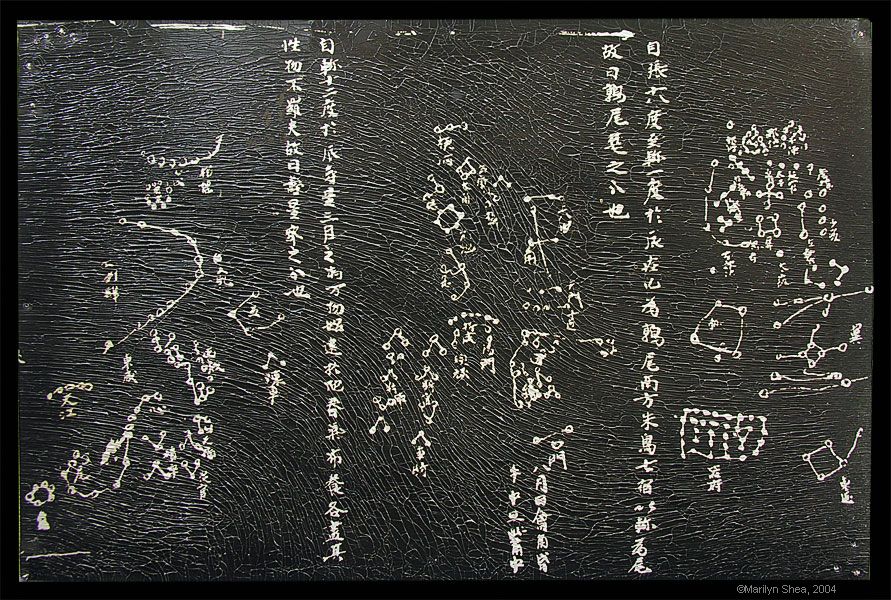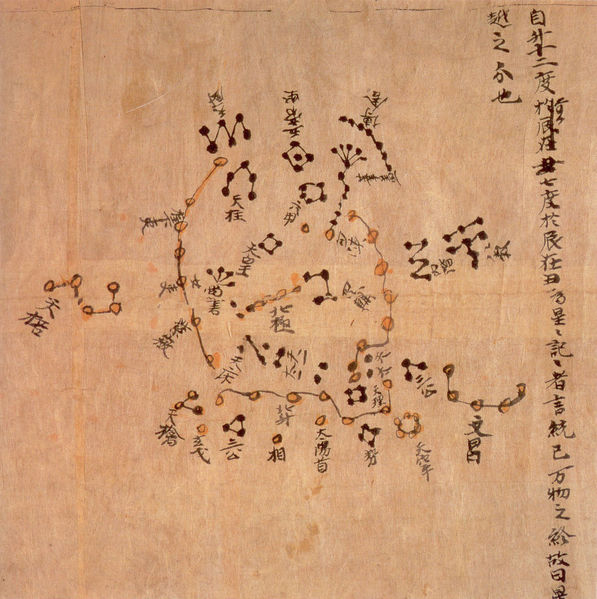 |
| The Dunhuang Star Map was found in the Dunhuang Mogao Grotto(敦煌莫高窟) in a cache of manuscripts in a covered alcove. At that time, the Grottos were all but abandoned and the monk who found them was selling manuscripts piece by piece to support himself and what was left of the monastary. In 1907, Aurel Stein and Paul Pelliot bought over 9000 objects and manuscripts from him. They sent trunks of items to Beijing to try to alert the government to the importance of the find, but most of the items disappeared into private collections. Much to the dismay of modern Chinese historians and archaeologists, the rest were sent to Europe. The Dunhuang Star Map is now housed in the International Dunhuang Project at the British Library.
The star map has recently been dated back to the 700s. Earlier it was thought to date to the 900s. The map contains 1,350 stars in thirteen sections. One of the most interesting features of the charts is that they used two different methods to display the stars. One was a cylindrical projection for the stars around the horizon. When you flatten a curved object it changes the relationship among the objects on the surface. It is like a Mercator projection first seen in Europe in 1568. Imagine cutting a ball to try to flatten it. You would have large segments of empty space between the slices of ball. On a cylindrical map, the lines of the ball are straightened artificially to maintain some relationship between the objects on the ball. This works fairly well on the equator or in the case of the sky, the horizon. When you get to the poles, the distances of the flattened slices are extremely distorted. To solve the problem, on the Dunhuang Star Map they used a circular polar projection method to draw the region around Polaris. That method, if used alone, would have distorted the measurements at the horizon. What was it doing in Dunhuang? Usually such materials would be found in imperial archives. It is speculation, but it could have been used to guide travelers along the Silk Road. Dunhuang was the last major resting place before starting on the journey on the north or south routes across the Taklamakan desert to the west. Above is a copy of a section of the map displayed in the Beijing Ancient Observatory and below is a photograph of a section from Wikipedia where a full resolution image is available. |
 |
| The stone star map above is a copy of one made in the Song Dynasty (960-1279). It hangs in the Ancient Observatory in Beijing. The original is housed in Suzhou. Below are photographs of a rubbing taken from the original.
During the Song Dynasty (宋朝), five star maps were created during different observation projects by imperial astronomers. The stone star map was first drawn during the reign of Emperor Yuanfeng (1078-85) and then carved into stone in 1247 by Wang Zhiyuan of the Southern Song Dynasty. On the map, the Milky Way can be seen as a large swath to the right of center. There are 1,434 stars mapped. In addition, the ecliptic, the equator, and the twenty-eight constellations are indicated. The lower part, which is not pictured, contains 209 characters, which give a sketch of the knowledge of the heavens at that time. It's the earliest complete map that still exists, although there were earlier complete maps. The oldest known star chart or map in Chinese history is the Shi Shi star chart drawn by Shi Shen in the Warring States Period (403-221 BC). It contained the stars of the 28 xiu or constellations and over 100 stars. And of course, the Dunhuang star map which dates to the 700s is not as complete as others. The Dunhuang map is probably a copy of another earlier map that is lost to history. During the Five Dynasties (907-960) history tells us there was another stone star map engraved between 941 and 960. That too is lost. |
http://hua.umf.maine.edu/China/beijing2.html
Last
update: May 2007
© Marilyn Shea, 2007